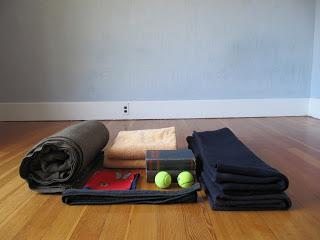In the coming weeks, I’ll be sharing my favorite supported inverted and calming poses with you. All of these poses require props of one sort or another. Now I know some people are reluctant to get started with props because they seem like such a hassle and maybe also because they’re seen as part of the whole distasteful “consumerist” aspect of yoga in America. But I’m afraid that for stress management, calming and restorative poses, props really are necessary. That’s because your body can relax much more effectively if it is being fully supported, rather than you having to use your muscles to support you.
However, using “props” doesn’t mean you need to run out and buy hundreds of dollars worth of specialized merchandise to duplicate what they have in your local yoga studio. In fact, for almost every prop we use in our poses, there is something in your house that you can use in its place.

Rolled Blankets, Folded Towels, Folded Blankets
Stacked Books, Tennis Balls, Silk Scarf, and
Bathrobe Sash
Straps. For a yoga strap substitute, look no further than your closet. Depending on which pose you’re doing, you can use an actual belt (leather or cloth). The sash from a bathrobe works quite well. You could even use an actual tie. And, yes, it’s nice to have one of those yoga strap buckles when you want to make a loop, but you could always tie a knot in the belt for the same effect. Just make sure that the cloth isn’t stretchy, as it won’t provide the necessary support if there is a lot of give to it.
Bolsters. I’d say if there’s one prop it’s worth investing in, a round bolster is my pick! Mine has lasted over 10 years, and has provided me with so much use and comfort.... That being said, you can “fake” a bolster by rolling a couple of blankets into a firm roll. Start with one single blanket that is folded into quarters. Then, from the narrow side, roll the blanket into a tight, firm roll. Then fold your second blanket into quarters. Finally, place the rolled-up first blanket on top of the flat second blanket, lining up the edges of both at narrow end, and then roll the second blanket around the first. Pretty close to a bolster, right? Another possibility is to use a sleeping bag that has been rolled up inside its bag for storage.
In many poses, the bolster doesn’t even need to be a round shape. In this case, you can fold some yoga blankets into long, thin rectangles and stack them on top of each other. This works well for reclined, supported poses, such as Reclined Cobbler’s pose, Reclined Hero pose, and Supported Savasana.
Blankets. The blankets used in yoga studios (and in our photographs) are wool, single-bed blankets, often from an Army Navy store. Because few people use real blankets any more, it’s a bit hard to find a substitute blanket in the house. The comforters and duvets we now use on our beds—when did that trend take over?—are too fluffy to provide any real support. However, when push comes to shove, a stack of towels can do the trick. Because towels are thinner than wool blankets, you’ll have to use more to achieve the same height. But some yoga studios, including some in India, use those very thin cotton hospital blankets, and you have to use quite a number of those, too. (I actually once taught yoga at a hospital, and we used those hospital blankets there, so I know. I’ve also done yoga in hotel rooms where I used the towels, so I know all about that, too.)
Yoga Mats. If you’re practicing on a wooden or carpeted floor, you might not even need a yoga mat at all for your standing poses. Try it and see. If you are resting your head on the floor, such as in an inverted pose, and the floor is too hard, you can put a thin towel under your head. You can also use a towel for cushioning your knees or any other part of your body.
Eye Pillows. An eye pillow has two functions. The first is to block out the light. For this purpose, you can drape a silk scarf or any other soft fabric over your eyes. The second purpose is to add a little weight to your eyelids, which can enhance relaxation. To add a little weight, you could wrap the silk scarf around a folded washcloth or even a small baggie filled with rice (hey, I just thought of that one).
Sandbags. So far, we haven’t been discussing and/or showing sandbags, but just so you know, a bag of rice or beans works just as well when you want to place a 1 or 5 pound weight on your body.
Be creative! Sometimes you can use various pieces of furniture in your house or hotel room, such as benches, ottomans, and coffee tables for various poses. I used to teach yoga in a room that had couches in it but no chairs, and at the end of class we used to do “Legs on a Couch pose,” which was my way of doing Easy Inverted pose. Baxter even uses a can of beans and rubber bands as props (see Friday Q&A: Bunions, a Can, and a Rubber Band). And we know teachers who use tennis and lacrosse balls for all kinds of evil—I mean, excellent—things.
That’s it for now, but if I’ve forgotten about anything important or you have some good ideas of your own, please let me know.

